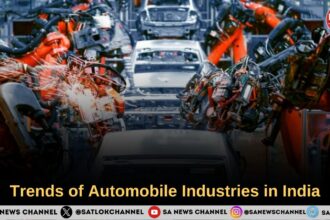When we hear the word robot, most of us imagine human-like machines mimicking our movements and behaviours. But in reality, not all robots have faces or even forms we recognise. Some are unperceived that they just work silently behind the screens and systems we use every day. This article explores the world of AI and robotics, uncovering how deeply they’ve embedded themselves into our daily lives, the profound impact they carry, and analyses this rapidly accelerating industry.
- Highlights
- What are Robots?
- Are All Robots AI-Powered?
- The Combination of AI and Robotics
- AI Robots Market
- AI and Robotics in Daily Lives
- Other Applications of AI and Robotics
- Healthcare
- Manufacturing and Logistics
- Agriculture
- Customer Service
- Energy and Infrastructure
- Defence Systems
- AI Robots in Space Technology
- Advantages and Disadvantages of AI and Robotics
- Is AI and Robotics Making Us Lazy and Leading US Astray?
- Are We Lost in Technology? The Forgotten Wisdom of The Supreme Creator
- FAQS: AI and Robotics
Highlights
- The global market for AI in robotics is projected to reach approximately USD 146.8 billion by 2033, rising significantly from USD 12.3 billion in 2023. (Source)
- This growth reflects a robust compound annual growth rate (CAGR) of 28.12% throughout the forecast period from 2024 to 2033. (Source)
Image Source: Market.us
- Machine Learning (ML) was embraced as the most sought-after technology worldwide in 2023 with a significant market share of about 45%. (Source)
- The country to experience the most dynamic changes in its AI and Robotics segment is China. The Chinese government is deeply invested in this field, giving AI and Robotics startups an additional push. (Source)
- Extremely high investment and running costs are big factors to consider in AI and robotics.
What are Robots?
Robots are mechanical devices designed to perform physical actions or tasks, often with precision and efficiency. They may or may not look like humans and the tasks carried out by them are either autonomously or through human intervention or direction.
They can be as simple as a robotic arm on a certain production line in a factory or as complex as self-navigating drones. Contrary to popular portrayal, most robots do not resemble humans. Instead, they take forms that best suit their functions, for example, industrial arms, rovers, drones or even software-based bots. What defines a robot is not its appearance, but its ability to sense, process and act within its environment.
Are All Robots AI-Powered?
Not all robots are powered by artificial intelligence. Most conventional robots operate based on fixed instructions that are programmed in advance. These machines operate in controlled settings and are excellent at repetitive tasks. For example, robots in manufacturing often repeat the same movement with high precision and minimal variability.
AI-powered robots, however, go a step further. They are capable of analysing data, recognising patterns, learning from experience and adapting to new inputs. This makes them suitable for environments where unpredictability and real-time decision-making are required. AI-enabled robots are capable of reacting to their environment, making decisions, and gradually enhancing their abilities through learning.
The Combination of AI and Robotics
Though Artificial Intelligence and Robotics are separate and vast fields individually, a small segment intersects these technologies. This subset is known as AI and Robotics.
Merging AI with robotics creates systems that are both physically capable and mentally adaptive. AI functions as the decision-making brain, while robotics serves as the body that executes actions. This powerful integration allows machines not only to perform tasks, but also to learn, improve and simultaneously, interact naturally with humans and their surroundings.
This combination is transforming the concept of automation. Unlike traditional machines that follow fixed routines, AI-robotic systems are built in order to adjust to changes, work in dynamic settings and handle unexpected scenarios. This is the base for applications such as autonomous vehicles, robotic caregivers and collaborative industrial robots, to name a few.
AI Robots Market
The AI robots market is undergoing rapid transformation with several governments across the world investing in AI and robotics.
- This trend is projected to persist in the coming years due to increasing global demand and innovation in the sector.
- A significant portion of this growth comes from start-ups, which now represent nearly 29% of all robotic firms worldwide, according to the International Federation of Robotics (IFR).
- Large tech companies are also playing a crucial role by backing the industry through investments and strategic acquisitions.
- One of the major drivers of this growth is the development of edge AI technology like chips that enable robots to perform high-level data processing locally. This allows data to be processed locally, eliminating the dependence on cloud-based servers.
- This advancement allows robots to respond in real time.
- From household robots to defence bots, AI robots are being used in diverse fields.
- A well-known example is Pepper, a humanoid robot used by Nestlé in Japanese stores to assist customers and promote products.
The Software and Hardware Segments Behind AI Robots
AI robots rely on both software and hardware components to function intelligently. The software side includes AI platforms and specialised applications that give robots their ability to learn, adapt and make decisions. This segment holds a larger share of the market, driven by advancements in machine learning tools, speech and vision interfaces and development kits tailored to robotics. These tools allow AI robots to process sensory data, recognise objects and voices, and eventually, improve performance through experience.
Image Source: Markets and Markets
The chart illustrates how the software segment in AI and robotics surpasses the hardware segment in terms of prominence.
On the hardware front, core components such as processors, memory units and connectivity modules are essential. In 2021, processors made up the largest share of hardware usage, highlighting their critical role in enabling real-time computing. As technology evolves, there’s a growing shift toward compact, energy-efficient processors like neuromorphic chips, which are designed to mimic the structure and function of the human brain. These chips are expected to change how robots process information by significantly increasing speed and reducing power consumption.
AI and Robotics in Daily Lives
AI and robotics have quietly transitioned from industrial spaces and research labs into our daily lives. While we may not always notice them, here are some examples of AI and robotics in daily lives. You might be surprised to learn that most devices or technology you thought was just AI-powered, is actually a combination of AI and Robotics:
Smart Homes
- Virtual Assistants: Devices like Amazon Alexa, Google Assistant and Apple’s Siri use AI-powered voice recognition to perform tasks such as playing music, setting alarms, controlling appliances and answering queries. The voice recognition factor born out of the combination of AI and robotics.
- Smart Thermostats: Products like Nest, for example, use AI to learn your temperature preferences and daily routines. Through these learnings, such devices automatically adjust the heating and cooling systems accordingly to save energy.
- Robotic Cleaners: Robotic vacuum cleaners map your home, detect dirt-prone areas and clean autonomously. These robots are built to adjust to different floor types and navigate around obstacles efficiently. Robotic vacuum cleaners were especially in demand in India during the COVID-19 pandemic when househelps couldn’t come home.
Smartphones
- Facial Recognition: Apple’s Face ID uses 3D facial mapping and machine learning to securely unlock your device and authorise payments.
- Camera AI: Most modern phones use AI to enhance photos by improving lighting. It also identifies scenes, for example food or portraits, and applies filters automatically.
- Typing Support: Predictive text and auto-correct features learn our personal writing style to help us compose messages faster.
Transportation
- Navigation: Apps like Google Maps and Waze analyse real-time traffic data using AI to suggest the fastest routes, avoid congestion and also alert about hazards.
- Ride-Sharing: Platforms like Uber and Ola use AI to match drivers and riders. These AI-powered devices estimate arrival times and apply surge pricing during peak hours.
- Autonomous Vehicles: Companies like Tesla and Waymo are developing self-driving cars that use AI. These cars are also robots that use AI technology.
E-Commerce
- Product Recommendations: Amazon, Flipkart and other online sellers track your browsing and purchase behaviour to suggest products using AI algorithms.
- Customer Support: AI-powered chatbots are also AI robots.
Finance
- Fraud Detection: AI robots monitor transaction patterns and flags suspicious activity, such as sudden spending in two distant locations.
- Banking Bots: Many banks use AI chatbots that are actually AI robots, to assist users with account related services.
Education
- Personalised Learning: Apps like Duolingo are in reality robots that use AI to adapt lessons to your learning pace and strengths.
- Smart Robotic Tools: Tools such as Photomath use AI to read handwritten equations via camera and provide step-by-step solutions.
Other Applications of AI and Robotics
Apart from everyday consumer use, AI and robotics are used in large-scale operations across various industries. Let us take a look at some prominent examples:
Healthcare
- Surgical Robotics: Systems like the da Vinci robot assist doctors in performing precise, minimally invasive surgeries. On the flip side, not just the cost, but also the realisation of a robot conducting surgeries is scary for most people.
- Medical Diagnostics: AI models, such as Google’s DeepMind, are capable of diagnosing diseases (like eye conditions or cancers) supposedly with expert-level accuracy.
- Elderly Care: Companion robots like ElliQ have been devised to engage elderly users in conversation, remind them to take medicines and alert their caregivers in emergencies.
Manufacturing and Logistics
- Automation: In manufacturing, robotic arms are commonly employed to handle repetitive tasks such as welding, assembling components, and painting with speed and consistency.
- Predictive Maintenance: AI robotic devices can predict when machines are likely to fail. This allows for proactive servicing and avoids costly downtime.
- Warehouse Robotics: Amazon’s fulfilment centres use Kiva robots to move inventory.
Agriculture
- Precision Farming: AI-powered drones are used to monitor crop health, detect pest infestations.and assess irrigation needs from the air.
- Smart Tractors: GPS-guided and AI-integrated tractors automate sowing, watering and harvesting.
Customer Service
- 24/7 Support: AI chatbots on websites and apps handle vast numbers of enquiries simultaneously. These are also AI robots. These are capable of booking appointments, providing updates or troubleshooting.
- Sentiment Analysis: AI robotics tools are used to analyse customer feedback across online platforms to detect dissatisfaction or emerging product issues.
Energy and Infrastructure
- Smart Grids: AI robots are deployed to predict electricity usage patterns in smart grids. They can help balance load and integrate renewable sources like solar and wind more efficiently.
- Urban Planning: Some cities use AI robots for traffic light optimisation, surveillance and public safety management.
Defence Systems
Artificial intelligence is being increasingly used in defence systems today.
- AI robots carry out tasks such as monitoring, threat detection and bomb disposal.
- These intelligent machines can operate in hazardous zones, analyse surroundings, and make rapid decisions without waiting for human commands.
- Military drones powered by AI can patrol borders, gather tactical data and assist in combat scenarios. This helps reduce risks to soldiers
AI Robots in Space Technology
AI-driven robots have been incorporated in space exploration.
- Rovers that have been sent to planets like Mars use advanced algorithms to navigate tough terrain, collect scientific samples and conduct experiments without direct human control.
- AI robots also help manage satellite functions, avoid space debris and support autonomous decision-making in deep-space missions.
- These technologies are believed to enable the possibility of exploring distant parts of our universe with greater safety, precision and efficiency.
Advantages and Disadvantages of AI and Robotics
As with all technology, there is both a positive and a negative side to AI and Robotics as well:
Advantages of AI and Robotics
- High Efficiency: Robots operate with speed and consistency. This reduces delays.
- Safety: Robots can take on high-risk tasks in unsafe conditions, helping to safeguard human workers from potential harm.
- Accuracy: Machines are believed to often achieve higher precision than humans, especially in surgeries or technical manufacturing. Though this point is debatable.
- Round-the-Clock Operation: Robots can perform operations 24/7 without a break.
Disadvantages and Challenges
- Job Losses: Automation is replacing many low-skill or repetitive jobs. This has resulted in workforce displacement.
- Initial Investment: Setting up AI-robotic systems requires substantial capital and technical expertise. It is extremely expensive.
- Ethical and Legal Concerns: Questions around accountability and fairness have always arisen when machines make decisions.
- Lack of Empathy: Robots lack the ability to experience emotions or make ethical decisions in the way humans do. Therefore, their role in care-based professions is limited.
- Security Vulnerabilities: AI systems are easy targets for hacking. This poses a great risk of data breaches or system failures.
Is AI and Robotics Making Us Lazy and Leading US Astray?
Whenever people question whether AI and robotics are making us increasingly lazy and passive, or even ask if we truly need these technologies in our lives, experts often categorically dismiss such concerns. Their usual defence? AI and robotics are capable of performing functions that are beyond human ability.
A commonly cited example is the search for life on other planets. Over the years, numerous AI-powered robots have been launched into space to perform tasks like capturing images, analysing terrain and collecting soil samples. NASA’s Curiosity rover is a notable case. After its debut mission to Mars in 2011, it was upgraded using AI technologies to undertake even more complex tasks in its subsequent explorations.
The scientific community justifies this pursuit by claiming that these intelligent machines are doing what humans physically can’t – exploring the unreachable. But here lies a much deeper, eye-opening question: Why are we so obsessed with analysing lifeless planets that were never ‘meant’ to sustain life in the first place?
The answer lies in a fundamental void, a lack of true spiritual knowledge.
Jagatguru Tatvdarshi Sant Rampal Ji Maharaj has already unveiled the profound truths of not just this universe, but countless others – truths no scientist can ever access, because they are based on sacred knowledge preserved in our ancient texts – wisdom that only a Tatvdarshi Sant (Enlightened Saint) has the insight to interpret. These scriptures, provided by none other than our Supreme Creator, God Kabir, reveal knowledge far beyond the reach of AI, robots, scientists, telescopes and rovers.
Before jumping to any conclusion and leaning towards science claims, we must ask ourselves – Who truly knows the full nature of any creation? An observer or its own Creator? Just as the engineer who built a machine best understands its parts and purpose, similarly, so too does our Supreme Creator alone possess the complete understanding of this vast cosmos.
Only God Kabir, the Divine Originator of all that exists, holds the complete understanding of every realm, celestial body and living being. The time has come for humanity to seek this divine knowledge and discover the real origin of our existence, and our actual purpose of life on Earth as humans.
Are We Lost in Technology? The Forgotten Wisdom of The Supreme Creator
Jagatguru Tatvdarshi Sant Rampal Ji Maharaj has revealed the complete story of the creation of nature, as disclosed by the Supreme God Himself. The true Father of all souls, Supreme God Kabir resides in Satlok, an eternal divine realm untouched by death, pain or illusion. Satlok is not only God’s abode but also the original home of every soul across all universes.
In stark contrast, Earth belongs to a mortal realm that is part of a complex system of 21 universes ruled by Kaal Brahm, also known as Satan. These 21 universes were once part of the eternal Satlok until we committed a devastating sin, leading to the exile of Kaal Brahm and countless souls. Since then, we’ve been trapped in this temporary and suffering-filled world, far from our true home.
Image Title: Pictorial Depiction of Kaal Brahm dominion of 21-universes (Page 28 of Gyan Ganga authored by Sant Rampal Ji Maharaj)
While today’s world celebrates AI and robotics as groundbreaking advancements, especially in the exploration of planets, the real question we must ask ourselves is – What are we really achieving? Collecting rocks, soil and signals from lifeless planets may look impressive, but what value does it truly hold when those very planets were never designed to sustain life? They’re just tiny fragments of a much greater creation already made long ago by Supreme God Kabir.
Image Title: Pictorial Depiction of All Universes Created by Supreme God Kabir (Page 24 of the book Gyan Ganga authored by Sant Rampal Ji Maharaj)
The truth is, real success doesn’t lie in chasing lifeless stones or revolving celestial bodies. It lies in understanding why we were sent here, what sin caused our fall from the immortal realm, and how we can return to Satlok – our true, eternal home.
Today’s scientific pursuits are like a child marvelling at a toy, unaware of the home he’s been separated from. What is AI before the knowledge of the Creator Himself? What are rovers and rockets compared to the divine wisdom that governs all universes?
We are not advancing, we are distracted. And it’s time to wake up.
Discover the real reason behind your existence, the sin that led to our exile, and the way back to your true home in this eye-opening revelation by Jagatguru Tatvdarshi Sant Rampal Ji Maharaj:
FAQS: AI and Robotics
Question 1: Which AI is used in robotics?
Answer: Multiple forms of AI are used depending on the desired end result. Though Machine Learning remains a strong choice.
Question 2: Who is a famous AI robot?
Answer: Sophia is widely considered as the most popularly known robot.









